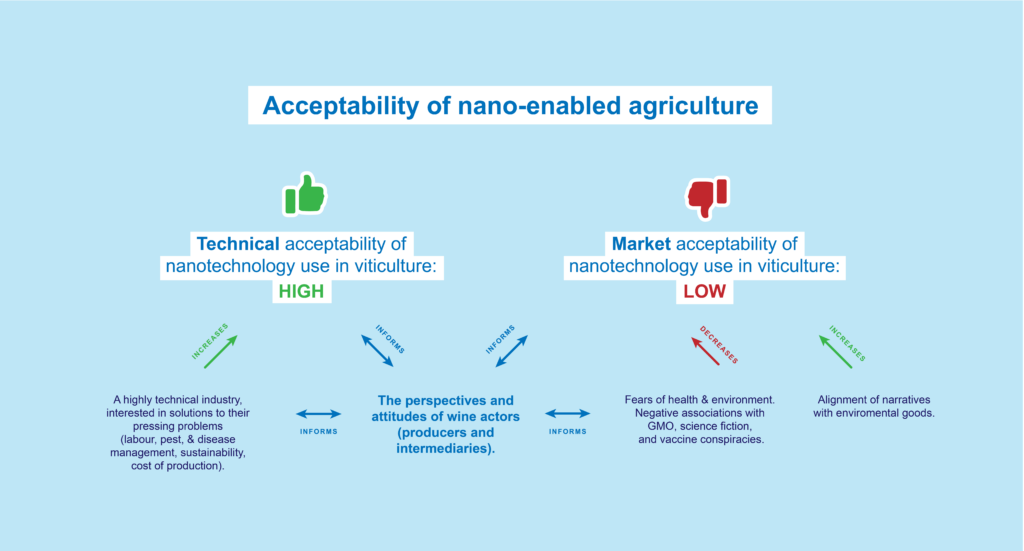By Nikolai Siimes
Nanotechnology is being rolled out in agriculture, but how will consumers, intermediaries, and authorities react? Through a series of interview of actors across the wine sector, this research looked into the acceptability of vineyard nanotechnology use in New Zealand. The perception and acceptability of nanotechnology is a vital consideration in attempts to bring nano-enabled products to market (Cummings et al., 2021; Liu et al., 2022; Wang et al., 2022). Despite this, there are few accounts of industry attitudes towards this recent shift, and fewer that consider it with regards to the governance of nanotechnology use. This study aims to fill that gap, with the results having been presented in Adelaide at the Australian Wine Industry Technical Conference (AWITC, 2022) as a poster, and a recently published paper in NanoImpact co-authored with Emma Sharp, Nick Lewis, and Melanie Kah.
In the paper, we depart from quantitative attempts to measure acceptability using standard statistical techniques. Instead, we use interview data from wine industry actors to identify key sensitivities, risks, and barriers to adoption. Our respondents argue that technical and market acceptability will respectively face different adoption hurdles and challenges, and that managing negative narratives will be critical for the latter (see Figure 1). Also, the alignment of nanotechnology with solid sustainability outcomes and environmental good is seen as increasing acceptability.

Figure 1: Technical and market acceptability.
Reprinted from NanoImpact, Vol 28, Siimes et al., Determining acceptance and rejection of nano-enabled agriculture, 100432.
Copyright (2022), with permission from Elsevier.
Nano-enabled agriculture is receiving substantial international attention as nanotechnologies and nano-agrochemicals are being developed and deployed for a variety of agricultural purposes (see Kah et al., 2019; Parisi et al., 2015; Wang et al., 2022). Nanotechnology can offer advantages for viticulturists in areas such as plant protection and pest management and winemakers in allowing the selective removal of undesirable compounds (Garde‐Cerdán et al., 2021; Loira et al., 2020; Mierczynska-Vasilev et al., 2017). These innovations rely on the novel properties that materials exhibit at the nanoscale. In particular, nanocopper and nanosulfur are suggested as potential applications with relevance to the global wine industry, as these could offer superior protection against pathogens such as powdery mildew or botrytis at low application rates. Other potential advantages include reduced labour needs, prolonged efficacy, and higher productivity.
Critics of nanotechnology worry about the rise of ‘franken-foods’, unknown health and environmental impacts, the loss of connection between people, nature, and place, and the favouring of agro-industrial business models premised on carbon intensive capitalism (Kearnes et al., 2006; Lyons et al., 2012; Richards et al., 2011). Impact assessments and regulation of nano-agrochemicals have been discussed globally (see EFSA Scientific Committee et al., 2021), but no studies have yet investigated conditions representative of vineyards. In the New Zealand context there are also unanswered questions surrounding the adequacy of existing regulatory frameworks (Gavaghan & Moore, 2011; Kihara, 2021), public perceptions (Cook & Fairweather, 2006), and Indigenous perspectives (Hutchings & Reynolds, 2005; Munshi et al., 2016).
Our research shows that technical acceptability of nano-enabled solutions (including nano-pesticides) is high. Winemakers, viticulturists, and industry authorities are interested in solutions to pressing issues such as labour, pest and disease management, and sustainability. Nanotechnology is perceived as compatible with the highly technical modes of viticulture that are already common in New Zealand. Obviously regulatory approval will be needed prior to nanotechnology adoption and this will be the next hurdle for any new nano-enabled products.
Market acceptability is less clear. We cannot predict how consumers and intermediaries will react to nano-enabled viticulture, and discursive and narrative management is needed at the producer and industry level. The main risks of nanotechnology are to the reputation and narratives of wine, even though nanoscale does not inherently make something more dangerous. Many producers rely on stories of wine as natural, traditional, and sustainable and nanotechnology could disrupt those marketing narratives. Nanotechnology can have negative connotations and interviewees worry about linking nanotechnology with genetic modification, weapons of mass destruction, and vaccine conspiracy theories.
Wine producers are interested in nanotechnology products with strong sustainability credentials that solve real issues they face. Interviewees suggest that nanotechnology offerings that provide both a resource saving and quality improvement are the most desirable, while eco-benefits are seen as key to ‘selling’ nanotechnology to consumers and intermediaries. Pressing issues for the industry include climate impact, labour, and pest and disease management. Innovation for innovations sake, or novel technology that lacks sustainability credentials are not appealing to the high value, narrative driven wine industry.
The research uncovered several new findings and documents previously unexplored attitudes towards vineyard nanotechnology. First, nanotechnology is seen as a potential solution to labour issues in the New Zealand wine industry. Second, nano products need environmental credentials to gain acceptance in winegrowing. Third, the impact of nanotechnology on existing wine narratives (upon which quality claims depend) is unclear, and further discursive work is required from AgTech firms, producers, and wine industry authorities. Fourth, wine intermediaries and ‘influencers’ will be more important than consumers in determining the acceptance of nanotechnology. Finally, similar perceptions studies based on qualitative research are required for individual novel nano-products during their development in order to reduce the risk of market rejection.
The research I have summarised above formed the backbone of my Master of Wine Science thesis at the University of Auckland and I wish to thank my supervisors Emma Sharp and Nick Lewis, as well as the interview participants without who this work would not be possible. I also want to acknowledge that my investigation is part of a larger project led by Melanie Kah, at the University of Auckland and funded by the Bragato Research Institute, the research arm of New Zealand Winegrowers (NZW 19-112). The broader project aims to fill knowledge gaps that will promote the responsible and sustainable application of nanotechnology in the New Zealand winegrowing sector. Currently, I am further investigating the interface of nanotechnology with organic wine, and interrogating whether nano-enabled approaches pose any particular threats or challenges in organic production regimes. I expect to publish these results in 2023.
For the full article see:
Siimes, N., Sharp, E. L., Lewis, N., & Kah, M. (2022). Determining acceptance and rejection of nano-enabled agriculture: A case study of the New Zealand wine industry. NanoImpact, 28, 100432.
https://doi.org/10.1016/j.impact.2022.100432
My master thesis is also available online :
Siimes, N. (2022). The Social Construction of Nanotechnology in the New Zealand Wine Industry (Thesis, ResearchSpace@ Auckland).
https://researchspace.auckland.ac.nz/handle/2292/59081

Nikolai Siimes is a doctoral researcher at the School of Environment, University of Auckland, New Zealand. His PhD focuses on the material and discursive role of more-than-human actors in wine production and wine economies, particularly the roles of technology and yeasts. He draws from his own experience in New Zealand winemaking to undertake research which helps bring about more sustainable and just futures for the wine sector.
References
- Cook, A. J., & Fairweather, J. R. (2006). Nanotechnology: Ethical and social issues : results from a New Zealand survey. https://hdl.handle.net/10182/129
Cummings, C. L., Kuzma, J., Kokotovich, A., Glas, D., & Grieger, K. (2021). Barriers to responsible innovation of nanotechnology applications in food and agriculture: A study of US experts and developers. NanoImpact, 23, 100326. https://doi.org/10.1016/j.impact.2021.100326 - EFSA Scientific Committee, More, S., Bampidis, V., Benford, D., Bragard, C., Halldorsson, T., Hernández‐Jerez, A., Hougaard Bennekou, S., Koutsoumanis, K., Lambré, C., Machera, K., Naegeli, H., Nielsen, S., Schlatter, J., Schrenk, D., Silano (deceased), V., Turck, D., Younes, M., Castenmiller, J., … Schoonjans, R. (2021). Guidance on risk assessment of nanomaterials to be applied in the food and feed chain: Human and animal health. EFSA Journal, 19(8). https://doi.org/10.2903/j.efsa.2021.6768
- Garde‐Cerdán, T., Souza‐da Costa, B., Rubio‐Bretón, P., & Pérez‐Álvarez, E. P. (2021). Nanotechnology: Recent advances in viticulture and enology. Journal of the Science of Food and Agriculture, 101(15), 6156–6166. https://doi.org/10.1002/jsfa.11406
- Gavaghan, C., & Moore, J. (2011). A Review of the Adequacy of New Zealand’s Regulatory Systems to Manage the Possible Impacts of Manufactured Nanomaterials. https://ourarchive.otago.ac.nz/handle/10523/6162
- Hutchings, J., & Reynolds, P. (2005). Maori and the ‘McScience” of new technologies Biotechnology and nanotechnology research and development. http://www.kaupapamaori.com/assets//hutching_renolds/maori_mcscienc.pdf
- Kah, M., Tufenkji, N., & White, J. C. (2019). Nano-enabled strategies to enhance crop nutrition and protection. Nature Nanotechnology, 14(6), 532–540. https://doi.org/10.1038/s41565-019-0439-5
- Kearnes, M., Macnaghten, P., & Wilsdon, J. (2006). Governing at the nanoscale: People, policies and emerging technologies. Demos.
- Kihara, S. (2021). Nanotechnology regulation in Aotearoa New Zealand: Current developments and comparison with overseas regulations. 46.
- Liu, P., Zheng, X., Shangguan, S., Zhao, L., Fang, X., Huang, Y., & Hermanowicz, S. W. (2022). Public Perceptions and Willingness-to-Pay for Nanopesticides. Nanomaterials, 12(8), 1292. https://doi.org/10.3390/nano12081292
- Loira, I., Morata, A., Escott, C., Del Fresno, J. M., Tesfaye, W., Palomero, F., & Suárez-Lepe, J. A. (2020). Applications of nanotechnology in the winemaking process. European Food Research and Technology, 246(8), 1533–1541. https://doi.org/10.1007/s00217-020-03519-7
- Lyons, K., Scrinis, G., & Whelan, J. (2012). Nanotechnology, Agriculture, and Food. In Nanotechnology and Global Sustainability. CRC Press.
- Mierczynska-Vasilev, A., Boyer, P., Vasilev, K., & Smith, P. A. (2017). A novel technology for the rapid, selective, magnetic removal of pathogenesis-related proteins from wines. Food Chemistry, 232, 508–514. https://doi.org/10.1016/j.foodchem.2017.04.050
- Munshi, D., Kurian, P. A., Morrison, T., & Morrison, S. L. (2016). Redesigning the architecture of policy-making: Engaging with Māori on nanotechnology in New Zealand. Public Understanding of Science, 25(3), 287–302. https://doi.org/10.1177/0963662514548629
- Parisi, C., Vigani, M., & Rodríguez-Cerezo, E. (2015). Agricultural Nanotechnologies: What are the current possibilities? Nano Today, 10(2), 124–127. https://doi.org/10.1016/j.nantod.2014.09.009
- Richards, C., Lawrence, G., & Burch, D. (2011). Supermarkets and Agro-industrial Foods. Food, Culture & Society, 14(1), 29–47. https://doi.org/10.2752/175174411X12810842291146
- Wang, D., Saleh, N. B., Byro, A., Zepp, R., Sahle-Demessie, E., Luxton, T. P., Ho, K. T., Burgess, R. M., Flury, M., White, J. C., & Su, C. (2022). Nano-enabled pesticides for sustainable agriculture and global food security. Nature Nanotechnology, 17(4), 347–360. https://doi.org/10.1038/s41565-022-01082-8

